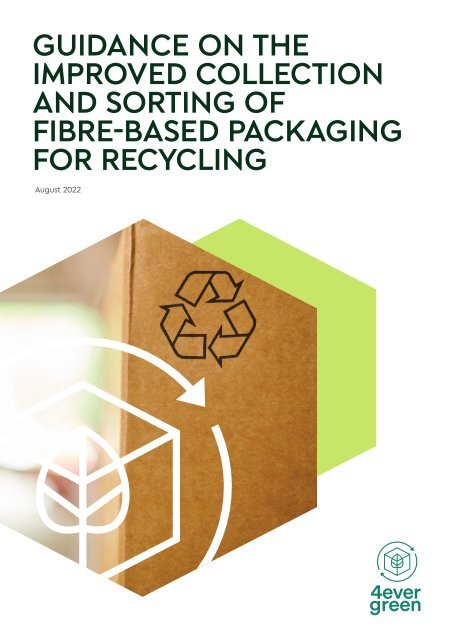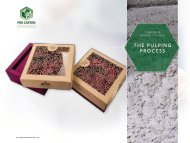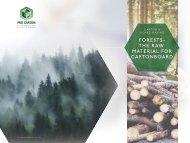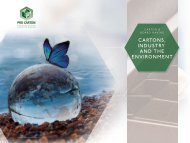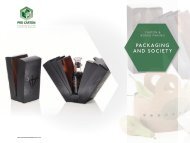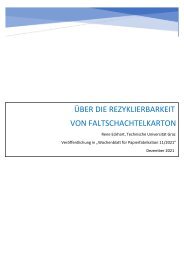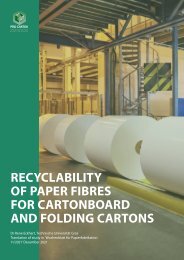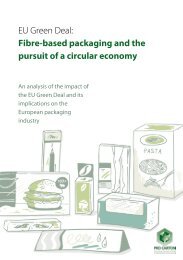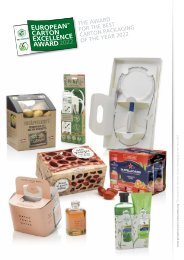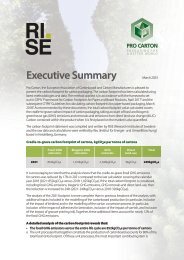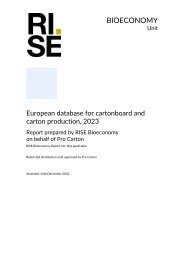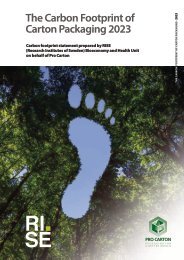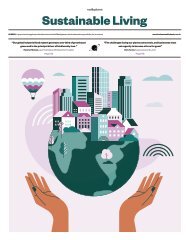Create successful ePaper yourself
Turn your PDF publications into a flip-book with our unique Google optimized e-Paper software.
GUIDANCE ON THE<br />
IMPROVED COLLECTION<br />
AND SORTING OF<br />
FIBRE-BASED PACKAGING<br />
FOR RECYCLING<br />
August 2022
1. Introducti<strong>on</strong><br />
4evergreen is a cross-industry alliance promoting lowcarb<strong>on</strong><br />
<strong>and</strong> circular fibre-<strong>based</strong> packaging. By bringing<br />
toge<strong>the</strong>r <strong>the</strong> entire value chain, <strong>the</strong> different work streams<br />
<strong>of</strong> 4evergreen aim <strong>for</strong> a comprehensive outlook <strong>on</strong> <strong>the</strong><br />
lifecycle <strong>of</strong> fibre-<strong>based</strong> packaging. In order to facilitate<br />
<strong>the</strong> eventual recycling <strong>of</strong> fibre-<strong>based</strong> packaging waste,<br />
collecti<strong>on</strong> <strong>and</strong> sorting is crucial.<br />
This ‘<str<strong>on</strong>g>Guidance</str<strong>on</strong>g> <strong>on</strong> <strong>the</strong> improved collecti<strong>on</strong> <strong>and</strong> sorting <strong>of</strong><br />
fibre-<strong>based</strong> packaging <strong>for</strong> recycling’, hereafter referred to<br />
as <strong>the</strong> <str<strong>on</strong>g>Guidance</str<strong>on</strong>g>, is <strong>based</strong> <strong>on</strong> input received from around<br />
50 participating companies from all relevant industry<br />
segments al<strong>on</strong>g <strong>the</strong> value chain. The <str<strong>on</strong>g>Guidance</str<strong>on</strong>g> reviews<br />
<strong>the</strong> pertinent regulatory <strong>and</strong> instituti<strong>on</strong>al frameworks <strong>and</strong><br />
provides an assessment <strong>of</strong> available collecti<strong>on</strong> <strong>and</strong> sorting<br />
scenarios.<br />
The recommendati<strong>on</strong>s in this <str<strong>on</strong>g>Guidance</str<strong>on</strong>g> are <strong>based</strong> <strong>on</strong> a<br />
c<strong>on</strong>sensus reached through discussi<strong>on</strong>s between work<br />
stream participants <strong>and</strong> experts. These recommendati<strong>on</strong>s<br />
are written <strong>based</strong> <strong>on</strong> best practices, <strong>and</strong> are intended to<br />
guide <strong>the</strong> implementati<strong>on</strong> <strong>of</strong> future collecti<strong>on</strong>, sorting<br />
<strong>and</strong> recycling infrastructure, in order to meet EU legal<br />
requirements <strong>and</strong> realise <str<strong>on</strong>g>4evergreen’s</str<strong>on</strong>g> aspirati<strong>on</strong>al<br />
targets including a 90% recycling rate <strong>for</strong> fibre-<strong>based</strong><br />
packaging. As such, this <str<strong>on</strong>g>Guidance</str<strong>on</strong>g> affects all key actors<br />
in <strong>the</strong> (fibre-<strong>based</strong>) packaging waste value chain (e.g.<br />
producers/importers, (local) authorities, waste h<strong>and</strong>lers/<br />
collectors, recyclers, NGOs), but is geared towards<br />
policymakers <strong>and</strong> packaging recovery organisati<strong>on</strong>s.<br />
The <str<strong>on</strong>g>Guidance</str<strong>on</strong>g> (<strong>and</strong> thus recommendati<strong>on</strong>s) will use sourceseparated<br />
collecti<strong>on</strong> within households as a starting point.<br />
Here, fibre-<strong>based</strong> packaging is to be collected in ei<strong>the</strong>r<br />
<strong>the</strong> regular paper <strong>and</strong> board stream or <strong>the</strong> lightweight<br />
packaging stream. The ‘routes’ from collecti<strong>on</strong> to recycling<br />
at dedicated paper <strong>and</strong> board mills are also examined,<br />
followed by practical recommendati<strong>on</strong>s how to improve<br />
collecti<strong>on</strong>.<br />
2<br />
August 2022
2. <strong>Fibre</strong>-<strong>based</strong> packaging<br />
waste recycling rate targets<br />
The EU has adopted material-by-material packaging waste<br />
recycling rate targets <strong>for</strong> both 2025 <strong>and</strong> 2030 1 :<br />
PACKAGING WASTE RECYCLING RATE TARGETS EU<br />
Year<br />
All<br />
packaging<br />
waste<br />
Plastic Wood Ferrous<br />
metals<br />
Aluminium Glass <strong>Fibre</strong>-<strong>based</strong><br />
2025 60% 50% 25% 70% 50% 70% 75%<br />
2030 70% 55% 30% 80% 60% 75% 85%<br />
Source: EU Directive 2018/852<br />
Note: <strong>Fibre</strong>-<strong>based</strong> packaging is named “paper <strong>and</strong> cardboard” packaging in <strong>the</strong> respective directive<br />
The above-menti<strong>on</strong>ed percentages can be c<strong>on</strong>sidered<br />
minimum targets as EU member states may implement<br />
even more ambitious packaging waste recycling targets<br />
in <strong>the</strong>ir respective nati<strong>on</strong>al legislati<strong>on</strong> (e.g. Germany,<br />
Spain <strong>and</strong> Sweden). Likewise, <strong>the</strong> aspirati<strong>on</strong>al goal <strong>of</strong><br />
4evergreen is to increase <strong>the</strong> overall (European) recycling<br />
rate <strong>of</strong> fibre-<strong>based</strong> packaging to 90% by 2030. To achieve<br />
this, <strong>the</strong> <str<strong>on</strong>g>Guidance</str<strong>on</strong>g> specifically focuses <strong>on</strong> (less developed)<br />
household collecti<strong>on</strong> ra<strong>the</strong>r than <strong>on</strong> commercial <strong>and</strong>/or<br />
industrial collecti<strong>on</strong>.<br />
How are <strong>the</strong>se targets derived? 4evergreen applies<br />
<strong>the</strong> most recent applicable calculati<strong>on</strong> rules used in EU<br />
Directive 2018/852 (article 6a, secti<strong>on</strong> 1b). These rules are<br />
<strong>based</strong> <strong>on</strong> <strong>the</strong> actual reprocessing <strong>of</strong> fibre-<strong>based</strong> packaging<br />
waste into recycled products.<br />
As such, 4evergreen proposes <strong>the</strong> following (source-bysource)<br />
recycling rate sub-targets:<br />
Commercial Industrial Household<br />
>90% >90% >85%<br />
50%<br />
0%<br />
1<br />
The UK has also set packaging waste recycling targets, broadly in line with <strong>the</strong> EU<br />
August 2022 3
3. Framework <strong>and</strong> boundaries<br />
4evergreen endorses several basic principles which are<br />
key in achieving fibre-<strong>based</strong> packaging waste recycling<br />
rate targets, regardless <strong>of</strong> <strong>the</strong> route from collecti<strong>on</strong> to<br />
recycling.<br />
In principle, all fibre-<strong>based</strong> packaging products are<br />
recyclable. Never<strong>the</strong>less, not every paper <strong>and</strong> board mill<br />
can actually recycle all types <strong>of</strong> fibre-<strong>based</strong> packaging.<br />
A perfectly fine raw material <strong>for</strong> <strong>on</strong>e mill could be a n<strong>on</strong>recyclable<br />
material <strong>for</strong> ano<strong>the</strong>r mill. Effective <strong>and</strong> efficient<br />
recycling thus requires that fibre-<strong>based</strong> packaging<br />
products end up in <strong>the</strong> designated paper <strong>and</strong> board mill<br />
which in turn requires matching collecti<strong>on</strong> <strong>and</strong> sorting<br />
systems.<br />
Source-separated collecti<strong>on</strong> <strong>of</strong> fibre-<strong>based</strong> packaging is<br />
fundamental. As such, 4evergreen endorses collecti<strong>on</strong><br />
systems where material is sorted into different streams<br />
at <strong>the</strong> source (e.g. households), laying a str<strong>on</strong>g<br />
foundati<strong>on</strong> <strong>for</strong> recycling at suitable paper <strong>and</strong> board<br />
mills.<br />
In this <str<strong>on</strong>g>Guidance</str<strong>on</strong>g>, a distincti<strong>on</strong> is made between two<br />
coexisting recycling streams <strong>for</strong> fibre-<strong>based</strong> packaging<br />
waste originating in households (both will be addressed<br />
in more detail in later chapters):<br />
With regard to <strong>the</strong> first stream, co-mingled collecti<strong>on</strong><br />
systems where dry recyclables (e.g. plastic, paper,<br />
metal, glass) are all collected in <strong>the</strong> same recycling<br />
stream are to be avoided, if necessary by regulati<strong>on</strong>.<br />
Following m<strong>and</strong>atory sorting at a material recycling<br />
facility, <strong>the</strong> resulting ‘paper <strong>for</strong> recycling’ fracti<strong>on</strong> rarely<br />
meets <strong>the</strong> quality requirements <strong>of</strong> European (st<strong>and</strong>ard)<br />
paper <strong>and</strong> board mills – in terms <strong>of</strong> unwanted materials<br />
<strong>and</strong> cross-c<strong>on</strong>taminati<strong>on</strong>. Instead, a dedicated collecti<strong>on</strong><br />
stream needs to be in place <strong>for</strong> clean (packaging <strong>and</strong> n<strong>on</strong>packaging)<br />
paper <strong>and</strong> board, excluding liquid packaging<br />
board <strong>and</strong> certain 2 fibre-<strong>based</strong> composite packaging. This<br />
will also be described in later chapters.<br />
With regard to <strong>the</strong> sec<strong>on</strong>d stream, mixed collecti<strong>on</strong><br />
systems are a well-established soluti<strong>on</strong> due to existing<br />
(<strong>and</strong> upcoming) sorting technologies linked to<br />
specialised paper <strong>and</strong> board mills. Targeted material<br />
may include plastic packaging, metal packaging, liquid<br />
packaging board <strong>and</strong> certain 2 fibre-<strong>based</strong> composite<br />
packaging. Glass should be kept separate.<br />
Despite good intenti<strong>on</strong>s by c<strong>on</strong>sumers to support<br />
recycling, fibre-<strong>based</strong> packaging products placed in <strong>the</strong><br />
‘wr<strong>on</strong>g’ recycling stream negatively affect <strong>the</strong> recycling<br />
process <strong>and</strong> could end up being sent to incinerati<strong>on</strong><br />
Stream 1:<br />
(Household collected)<br />
paper <strong>and</strong> board<br />
Stream 2:<br />
(Household collected)<br />
lightweight packaging<br />
2<br />
Specific in<strong>for</strong>mati<strong>on</strong> <strong>on</strong> this topic will be provided in a <strong>for</strong>thcoming 4evergreen <str<strong>on</strong>g>Guidance</str<strong>on</strong>g> which is expected at <strong>the</strong> end <strong>of</strong> 2022<br />
4<br />
August 2022
plants or l<strong>and</strong>fill. Public awareness <strong>and</strong> educati<strong>on</strong> about<br />
<strong>the</strong>se c<strong>on</strong>sequences is key.<br />
Today, fibre-<strong>based</strong> packaging products collected with<br />
<strong>and</strong> sorted from <strong>the</strong> residual waste stream are not<br />
c<strong>on</strong>sidered suitable <strong>for</strong> recycling in paper <strong>and</strong> board<br />
mills as fibres may have been c<strong>on</strong>taminated with organic<br />
waste.<br />
Naturally, littering must be avoided in all cases.<br />
Following <strong>the</strong> latest amendment <strong>of</strong> <strong>the</strong> <strong>Packaging</strong> <strong>and</strong><br />
<strong>Packaging</strong> Waste Directive (EU Directive 2018/852;<br />
article 7), European member states are required to<br />
implement nati<strong>on</strong>al extended producer resp<strong>on</strong>sibility<br />
schemes (EPR) by <strong>the</strong> end <strong>of</strong> 2024 3 . This obliges affected<br />
stakeholders (e.g. municipalities, producers) to, am<strong>on</strong>g<br />
o<strong>the</strong>r things, develop <strong>the</strong> required infrastructure to<br />
collect packaging waste separately at source (i.e.<br />
households <strong>and</strong> possibly also at <strong>the</strong> business level).<br />
Minimum requirements <strong>for</strong> such schemes have been set<br />
out in <strong>the</strong> latest amendment <strong>of</strong> <strong>the</strong> Waste Framework<br />
Directive (EU Directive 2018/851; article 8a).<br />
4evergreen is in support <strong>of</strong> legislative initiatives that<br />
incentivise more investment <strong>and</strong> <strong>the</strong> wider participati<strong>on</strong><br />
<strong>of</strong> all relevant stakeholders in separate collecti<strong>on</strong> <strong>and</strong><br />
post-collecti<strong>on</strong> sorting acti<strong>on</strong>s aimed at increasing <strong>the</strong><br />
recycling rate <strong>of</strong> fibre-<strong>based</strong> packaging.<br />
Moreover, 4evergreen supports EPR-fee structures<br />
which, to <strong>the</strong> largest extent possible, reflect <strong>the</strong> real<br />
net recycling costs <strong>for</strong> each type <strong>of</strong> packaging material.<br />
An ec<strong>on</strong>omic assessment should take into account<br />
(a) collecti<strong>on</strong> costs, (b) need <strong>for</strong> <strong>and</strong> cost <strong>of</strong> sorting/<br />
processing, (c) actual cost <strong>of</strong> recycling, <strong>and</strong> (d) <strong>the</strong> value<br />
<strong>of</strong> recyclates.<br />
This <str<strong>on</strong>g>Guidance</str<strong>on</strong>g>, <strong>and</strong> specifically <strong>the</strong> routes from household<br />
collecti<strong>on</strong> to recycling (i.e. Chapters 6 to 8), are written<br />
as a recommendati<strong>on</strong> <strong>for</strong> building future collecti<strong>on</strong>,<br />
sorting <strong>and</strong> recycling infrastructure. In every respect,<br />
4evergreen also supports alternative infrastructures<br />
capable <strong>of</strong> meeting <strong>the</strong> recycling rate (sub)targets<br />
described in Chapter 2.<br />
3<br />
The UK has indicated that it will implement similar EPR legislati<strong>on</strong><br />
August 2022 5
4. Focus <strong>on</strong> household collecti<strong>on</strong><br />
<strong>of</strong> fibre-<strong>based</strong> packaging<br />
In Europe (EU27 + NO, CH, UK) 47 milli<strong>on</strong> t<strong>on</strong>nes <strong>of</strong><br />
fibre-<strong>based</strong> packaging is c<strong>on</strong>sumed each year, <strong>of</strong> which<br />
42 milli<strong>on</strong> t<strong>on</strong>nes is collected 4 . The material collected<br />
comes from three different sources: households (21% – 9<br />
milli<strong>on</strong> t<strong>on</strong>nes), industrial (31% – 13 milli<strong>on</strong> t<strong>on</strong>nes) <strong>and</strong><br />
commercial (48% – 20 milli<strong>on</strong> t<strong>on</strong>nes) 4 . The material can<br />
ei<strong>the</strong>r be collected directly from <strong>on</strong>e <strong>of</strong> <strong>the</strong>se sources or<br />
be part <strong>of</strong> <strong>the</strong> municipal <strong>and</strong>/or dual selective collecti<strong>on</strong><br />
system <strong>and</strong> be classified as municipal solid waste (MSW).<br />
These sources have different characteristics <strong>and</strong> that have<br />
an impact <strong>on</strong> sorting needs:<br />
> Collecti<strong>on</strong> from commercial <strong>and</strong> industrial streams<br />
is <strong>of</strong>ten high quality <strong>and</strong> seldom requires sorting<br />
because <strong>of</strong> <strong>the</strong> high degree <strong>of</strong> separati<strong>on</strong> at source<br />
across Europe.<br />
> Municipal collecti<strong>on</strong> from households <strong>and</strong> (small)<br />
businesses, such as restaurants, requires in most<br />
cases post-collecti<strong>on</strong> sorting in <strong>the</strong> majority <strong>of</strong><br />
European geographies, with a heterogeneous<br />
l<strong>and</strong>scape <strong>of</strong> collecti<strong>on</strong> fracti<strong>on</strong>s.<br />
> Separate household collecti<strong>on</strong> sometimes requires<br />
collecti<strong>on</strong> sorting depending <strong>on</strong> <strong>the</strong> scheme<br />
in place, <strong>the</strong> level <strong>of</strong> c<strong>on</strong>sumer educati<strong>on</strong>, <strong>and</strong><br />
awareness <strong>of</strong> <strong>the</strong> source-separati<strong>on</strong> topic.<br />
These three sources have significantly different recycling<br />
rates with industrial <strong>and</strong> commercial at 85% <strong>and</strong> 88%<br />
respectively, while sorted household collecti<strong>on</strong> is at<br />
55% 5 . The mixed material (originating from households<br />
<strong>and</strong> commercial activities) collected through MSW has a<br />
recycling rate <strong>of</strong> 66% 6&7 .<br />
4evergreen c<strong>on</strong>cludes that focus needs to be put <strong>on</strong><br />
household collecti<strong>on</strong>, while maintaining high recycling<br />
rates <strong>for</strong> industrial <strong>and</strong> commercial collecti<strong>on</strong>, since <strong>the</strong><br />
current recycling rates need to be improved to reach an<br />
overall recycling rate <strong>of</strong> 90%. The 4evergreen guidance<br />
includes several steps that should be taken by countries,<br />
municipalities <strong>and</strong> o<strong>the</strong>r actors in <strong>the</strong> recycling value chain<br />
to make it easier <strong>for</strong> c<strong>on</strong>sumers to sort correctly, allowing<br />
<strong>the</strong> packaging to be sorted in <strong>the</strong> correct stream <strong>and</strong><br />
recycled into a new valuable resource. This should reduce<br />
<strong>the</strong> share <strong>of</strong> fibre-<strong>based</strong> packaging in mixed MSW <strong>and</strong><br />
increase <strong>the</strong> recyclability <strong>of</strong> <strong>the</strong> sorted household stream.<br />
IN EUROPE (EU27 + NO, CH, UK)<br />
47<br />
milli<strong>on</strong> t<strong>on</strong>nes<br />
<strong>of</strong> fibre-<strong>based</strong><br />
packaging is<br />
c<strong>on</strong>sumed each<br />
year<br />
Commercial<br />
48%<br />
20 milli<strong>on</strong><br />
t<strong>on</strong>nes<br />
42<br />
milli<strong>on</strong> t<strong>on</strong>nes<br />
is collected<br />
Households<br />
21%<br />
9 milli<strong>on</strong><br />
t<strong>on</strong>nes<br />
Industrial<br />
31%<br />
13 milli<strong>on</strong><br />
t<strong>on</strong>nes<br />
4<br />
RISI; Expert interviews; Press search; FAO; OECD; Cepi, team analysis<br />
5<br />
RISI; Expert interviews; Press search; FAO; OECD; Cepi, team analysis<br />
6<br />
There are differences between countries regarding <strong>the</strong> degree to which waste from commerce, trade, administrati<strong>on</strong> <strong>and</strong> even small industries<br />
is collected <strong>and</strong> managed toge<strong>the</strong>r with waste from households <strong>and</strong> defined as MSW<br />
7<br />
RISI; Expert interviews; Press search; FAO; OECD; Cepi, team analysis<br />
6<br />
August 2022
5. <strong>Recycling</strong> soluti<strong>on</strong>s<br />
The Waste Framework Directive named collecti<strong>on</strong> as a<br />
prec<strong>on</strong>diti<strong>on</strong> <strong>for</strong> quality recycling. Implementati<strong>on</strong> <strong>of</strong><br />
separate collecti<strong>on</strong> <strong>and</strong> adequate sorting <strong>of</strong> fibre-<strong>based</strong><br />
packaging is not <strong>on</strong>ly important to comply with European<br />
law, it is also necessary to create qualities that match <strong>the</strong><br />
most suitable recycling technology, thus increasing <strong>the</strong><br />
recycling rate.<br />
<strong>Recycling</strong> <strong>of</strong> fibre-<strong>based</strong> packaging into new paper <strong>and</strong><br />
board is an established technique in widespread use.<br />
In fact, fibre-<strong>based</strong> packaging can go through multiple<br />
cycles <strong>of</strong> producti<strong>on</strong>, use <strong>and</strong> recycling. The recycling<br />
processes are designed to maintain <strong>the</strong> quality <strong>of</strong> <strong>the</strong><br />
fibres, thus allowing multiple cycles. In every cycle, <strong>the</strong><br />
fibrous material must be cleaned <strong>of</strong> <strong>for</strong>eign materials,<br />
such as staples, laminates <strong>and</strong> adhesive applicati<strong>on</strong>s. This<br />
can lead to some loss <strong>of</strong> fibrous material <strong>and</strong> a natural<br />
degradati<strong>on</strong> <strong>of</strong> fibres. Depending <strong>on</strong> <strong>the</strong> end applicati<strong>on</strong>,<br />
it can require virgin fibres to be added to <strong>the</strong> process.<br />
With respect to <strong>the</strong> input material, <strong>the</strong>re are three main<br />
types <strong>of</strong> paper recycling processes. The detailed set<br />
up <strong>and</strong> level <strong>of</strong> complexity <strong>of</strong> <strong>the</strong> processes are also<br />
determined by <strong>the</strong> end product <strong>the</strong>y produce. Comm<strong>on</strong><br />
to all types is a pulping stage which disintegrates <strong>the</strong><br />
paper <strong>and</strong> board structure into individual fibres <strong>and</strong><br />
cleaning <strong>and</strong> screening stages.<br />
a. Mills with st<strong>and</strong>ard equipment typically treat old<br />
corrugated c<strong>on</strong>tainerboard (OCC) <strong>and</strong>/or mixed<br />
paper <strong>and</strong> mainly reject n<strong>on</strong>-paper c<strong>on</strong>stituents <strong>and</strong><br />
<strong>the</strong> <strong>for</strong>eign parts menti<strong>on</strong>ed above. The output is a<br />
brownish pulp.<br />
b. De-inking mills have similar cleaning <strong>and</strong> screening<br />
stages but also remove <strong>the</strong> ink. Inputs here are<br />
paper <strong>and</strong> board products <strong>on</strong> bleached substrates,<br />
<strong>and</strong> <strong>the</strong> output is a white or <strong>of</strong>f-white pulp.<br />
c. Paper <strong>and</strong> board <strong>for</strong> recycling, which cannot be<br />
recycled efficiently under a. <strong>and</strong> b., needs a special<br />
process. One well-established process c<strong>on</strong>cerns<br />
liquid packaging board (LPB), also known as<br />
beverage cart<strong>on</strong>s. Typically, this is a two-sided<br />
laminati<strong>on</strong> that needs an enhanced pulping acti<strong>on</strong><br />
<strong>and</strong> a reject system <strong>for</strong> higher quantities. Similar<br />
processes can be adapted <strong>and</strong> optimised <strong>for</strong> wetstrength<br />
products <strong>and</strong> certain 8 o<strong>the</strong>r fibre-<strong>based</strong><br />
composite packaging (FBCP), i.e. packaging<br />
composed <strong>of</strong> two or more materials, where <strong>the</strong> predominant<br />
material is paper. Depending <strong>on</strong> product<br />
design <strong>and</strong> <strong>the</strong> type <strong>and</strong> amount <strong>of</strong> n<strong>on</strong>-paper<br />
c<strong>on</strong>stituents used, part <strong>of</strong> <strong>the</strong>se products could be<br />
suitable <strong>for</strong> collecti<strong>on</strong> via <strong>the</strong> household paper <strong>and</strong><br />
board stream, <strong>and</strong> <strong>the</strong>n recycled in st<strong>and</strong>ard mills.<br />
Specific in<strong>for</strong>mati<strong>on</strong> <strong>on</strong> this topic will be provided<br />
in a <strong>for</strong>thcoming 4evergreen guidance which is<br />
expected at <strong>the</strong> end <strong>of</strong> 2022.<br />
Paper <strong>for</strong> recycling is generally a blend <strong>of</strong> different fibre<strong>based</strong><br />
products. If <strong>the</strong> variety <strong>of</strong> products is low, such<br />
as in <strong>the</strong> treatment <strong>of</strong> liquid packaging board, additi<strong>on</strong>al<br />
process steps are being put in place to recover <strong>and</strong><br />
recycle <strong>the</strong> n<strong>on</strong>-paper c<strong>on</strong>stituents (e.g. ‘polyal’ from<br />
liquid packaging board).<br />
It is important that <strong>the</strong> collecti<strong>on</strong> <strong>and</strong> sorting set-up<br />
guides <strong>the</strong> different paper grades towards <strong>the</strong> right<br />
recycling process <strong>and</strong> end use to secure <strong>the</strong> highest<br />
quality <strong>and</strong> yield <strong>of</strong> recovered material across different<br />
types <strong>of</strong> recycling mills processing different types <strong>of</strong><br />
fibre-<strong>based</strong> materials. Moreover, each paper mill will<br />
have its own special recipe <strong>and</strong> appropriate technical<br />
equipment related to <strong>the</strong> properties <strong>of</strong> <strong>the</strong> intended end<br />
products.<br />
The highest efficiency <strong>and</strong> recycling rates will thus be<br />
obtained by ensuring that paper mills have access to<br />
fibre-<strong>based</strong> material that is collected <strong>and</strong> sorted into<br />
different feedstock fracti<strong>on</strong>s with sufficient quality to<br />
create <strong>the</strong> required recipe <strong>for</strong> <strong>the</strong>ir own products.<br />
8<br />
Specific in<strong>for</strong>mati<strong>on</strong> <strong>on</strong> this topic will be provided in a <strong>for</strong>thcoming 4evergreen <str<strong>on</strong>g>Guidance</str<strong>on</strong>g> which is expected at <strong>the</strong> end <strong>of</strong> 2022<br />
August 2022 7
6. The st<strong>and</strong>ard mill route<br />
The majority <strong>of</strong> fibre-<strong>based</strong> products originating from<br />
households, both packaging <strong>and</strong> n<strong>on</strong>-packaging, can be<br />
easily collected <strong>and</strong> recycled in <strong>the</strong> same stream. Targeted<br />
material needs to c<strong>on</strong><strong>for</strong>m to <strong>the</strong> collecti<strong>on</strong> requirements<br />
as set out in <strong>the</strong> secti<strong>on</strong> <strong>on</strong> <strong>the</strong> household route <strong>for</strong> fibre<strong>based</strong><br />
packaging. From <strong>the</strong>re, two major sub-routes are<br />
possible:<br />
Household<br />
collected paper<br />
<strong>and</strong> board (PB)<br />
> Source separated<br />
> Both packaging <strong>and</strong><br />
o<strong>the</strong>r paper <strong>and</strong> board<br />
(e.g. newspapers <strong>and</strong><br />
magazines)<br />
> Excluding liquid<br />
packaging board <strong>and</strong><br />
certain 9 fibre-<strong>based</strong><br />
composite packaging.<br />
Pressing/<br />
quality checks<br />
Household collected<br />
paper <strong>and</strong> board<br />
Mixed<br />
paper<br />
St<strong>and</strong>ard mill<br />
OCC<br />
De-ink sorting line<br />
De-ink<br />
De-inking mill<br />
Not depicted in <strong>the</strong> flowchart: O<strong>the</strong>r (n<strong>on</strong>-packaging) flows destined <strong>for</strong> de-inking mills <strong>and</strong> eventual mixed paper<br />
flows from de-ink sorting lines to st<strong>and</strong>ard mills.<br />
In principle, <strong>the</strong> household collected paper <strong>and</strong> board<br />
described above is ready <strong>for</strong> recycling in st<strong>and</strong>ard<br />
paper <strong>and</strong> board mills. As material is already sorted<br />
by households, no fur<strong>the</strong>r sorting is required. Prior to<br />
reaching <strong>the</strong> mill, <strong>the</strong> bulk <strong>of</strong> <strong>the</strong> material will be pressed<br />
into industrial size bales <strong>of</strong> ‘paper <strong>for</strong> recycling’ <strong>and</strong><br />
checked <strong>for</strong> quality in dedicated plants. Here again,<br />
c<strong>on</strong>sumers play a vital role in <strong>the</strong> (at source) sorting<br />
process, <strong>and</strong> public educati<strong>on</strong> is key.<br />
Alternatively, <strong>the</strong> household collected paper <strong>and</strong> board<br />
can be h<strong>and</strong>led at dedicated (de-inking) sorting lines.<br />
This generally splits <strong>the</strong> stream in two: a de-ink stream<br />
(e.g. mainly used newspapers <strong>and</strong> magazines) which<br />
can be c<strong>on</strong>sumed by de-inking mills <strong>and</strong> an OCC stream<br />
(e.g. mainly used packaging) which can be c<strong>on</strong>sumed in<br />
st<strong>and</strong>ard paper <strong>and</strong> board mills.<br />
From <strong>the</strong> perspective <strong>of</strong> both st<strong>and</strong>ard <strong>and</strong> de-inking mills,<br />
EN643 is regarded as <strong>the</strong> applicable industry st<strong>and</strong>ard,<br />
providing a detailed grading list <strong>for</strong> batches <strong>of</strong> paper <strong>for</strong><br />
recycling, entailing:<br />
> For all grades<br />
- Hazardous waste tolerance (zero tolerance)<br />
- Moisture tolerance (maximum 10%)<br />
> For each grade<br />
- C<strong>on</strong>tent descripti<strong>on</strong><br />
- Tolerance level <strong>for</strong> n<strong>on</strong>-paper comp<strong>on</strong>ents<br />
(e.g. plastic, metal, not part <strong>of</strong> <strong>the</strong> product)<br />
- Tolerance level <strong>for</strong> o<strong>the</strong>r unwanted material<br />
(e.g. material detrimental <strong>for</strong> producti<strong>on</strong>)<br />
The abovementi<strong>on</strong>ed (sub)routes allow <strong>for</strong> recycling<br />
grades c<strong>on</strong><strong>for</strong>m EN643 (i.e. mixed paper: 1.01/1.02;<br />
OCC: 1.04; de-inking: 1.11).<br />
9<br />
Specific in<strong>for</strong>mati<strong>on</strong> <strong>on</strong> this topic will be provided in a <strong>for</strong>thcoming 4evergreen <str<strong>on</strong>g>Guidance</str<strong>on</strong>g> which is expected at <strong>the</strong> end <strong>of</strong> 2022<br />
8<br />
August 2022
7. The enhanced mill route<br />
Liquid packaging board (LPB) is already being collected<br />
with lightweight packaging (LWP) in many countries<br />
across Europe (mainly toge<strong>the</strong>r with plastic <strong>and</strong> metal<br />
packaging), separating <strong>the</strong>m at source from o<strong>the</strong>r paper<br />
<strong>and</strong> board. In some countries, such as Germany, o<strong>the</strong>r<br />
fibre-<strong>based</strong> composite packaging (FBCP) is also accepted<br />
in <strong>the</strong> lightweight packaging collecti<strong>on</strong>. Typically, LWP is<br />
sent to a dedicated sorting plant capable <strong>of</strong> separating<br />
<strong>the</strong> LWP into different materials suitable <strong>for</strong> recycling. For<br />
fibre-<strong>based</strong> packaging, two qualities are being separated<br />
<strong>for</strong> recycling, i.e. LPB <strong>and</strong> o<strong>the</strong>r FBCP:<br />
LPB <strong>and</strong> similar<br />
Household<br />
collected lightweight<br />
packaging (LWP)<br />
> Source separated<br />
> Including liquid packaging<br />
board (LPB), plastic<br />
packaging <strong>and</strong> metal<br />
packaging <strong>and</strong> certain 10<br />
fibre-<strong>based</strong> composite<br />
packaging (FBCP)<br />
LWP<br />
LWP sorting<br />
plant<br />
O<strong>the</strong>r FBCP<br />
Enhanced LPB<br />
mill<br />
Enhanced<br />
FBCP mill<br />
EN643 describes some fibre-<strong>based</strong> multi-material grades<br />
<strong>for</strong> recycling, such as liquid packaging board or cups,<br />
but <strong>the</strong> variety <strong>of</strong> <strong>the</strong>se materials is increasing. Also, <strong>the</strong><br />
n<strong>on</strong>-paper c<strong>on</strong>stituents need to be c<strong>on</strong>sidered <strong>for</strong> recycling.<br />
There<strong>for</strong>e, <strong>the</strong> existing classificati<strong>on</strong> <strong>for</strong> <strong>the</strong>se materials<br />
within EN643 is no l<strong>on</strong>ger granular enough to meet all <strong>the</strong><br />
requirements <strong>for</strong> recycling. New or improved st<strong>and</strong>ards<br />
are required to cover innovative barrier paper packaging<br />
soluti<strong>on</strong>s entering a fast-evolving market.<br />
For this reas<strong>on</strong>, as an interim but not comprehensive<br />
soluti<strong>on</strong>, enhanced recycling mills are applying bilateral<br />
commitments <strong>on</strong> specific input requirements bey<strong>on</strong>d<br />
EN643, which are c<strong>on</strong>sequently a guideline <strong>for</strong> sorting<br />
plants to produce <strong>the</strong>se qualities. An example from<br />
Germany can be highlighted. Specificati<strong>on</strong> n° 512 is in place<br />
to describe <strong>the</strong> quality needed <strong>for</strong> liquid packaging board<br />
to be recycled in dedicated enhanced mills. Fur<strong>the</strong>rmore,<br />
enhanced mills capable <strong>of</strong> processing o<strong>the</strong>r FBCP can rely<br />
<strong>on</strong> sorting according to specificati<strong>on</strong> n° 550.<br />
This sorting is important as an enhanced recycling mill<br />
is not necessarily capable <strong>of</strong> recycling all fibre-<strong>based</strong><br />
packaging types. Indeed, an enhanced mill developed to<br />
recycle liquid packaging board or materials with a similar<br />
compositi<strong>on</strong> will not automatically be able to recycle<br />
o<strong>the</strong>r fibre-<strong>based</strong> composite materials. The technology<br />
being used in an enhanced mill is linked to dissolving/<br />
disintegrati<strong>on</strong> time, fibre quality <strong>and</strong> properties, additives,<br />
agents, adhesives, fillers, n<strong>on</strong>-fibre comp<strong>on</strong>ents but also<br />
<strong>the</strong> purity <strong>of</strong> feedstock bales coming from sorting.<br />
Deviati<strong>on</strong>s at <strong>the</strong> packaging material level can impact <strong>the</strong><br />
established recycling process at <strong>the</strong> paper mill <strong>and</strong> lead to<br />
inefficiencies. There<strong>for</strong>e, <strong>the</strong> sorting step is a necessity to<br />
secure that enhanced mills can source <strong>the</strong> qualities <strong>the</strong>y are<br />
able to recycle with <strong>the</strong> installed equipment <strong>and</strong> taking into<br />
account <strong>the</strong> requirements <strong>of</strong> <strong>the</strong>ir end products.<br />
Specific industry st<strong>and</strong>ards bey<strong>on</strong>d EN643 – determining<br />
<strong>the</strong> input requirements <strong>for</strong> special grades treated by<br />
enhanced recycling mills <strong>and</strong> applied c<strong>on</strong>sequently as a<br />
guideline <strong>for</strong> sorting plants – can secure qualities needed<br />
<strong>for</strong> recycling, as well as <strong>for</strong> <strong>the</strong> n<strong>on</strong>-fibre c<strong>on</strong>stituents, <strong>and</strong><br />
support investments in additi<strong>on</strong>al recycling capacity.<br />
10<br />
Specific in<strong>for</strong>mati<strong>on</strong> <strong>on</strong> this topic will be provided in a <strong>for</strong>thcoming 4evergreen <str<strong>on</strong>g>Guidance</str<strong>on</strong>g> which is expected at <strong>the</strong> end <strong>of</strong> 2022<br />
August 2022 9
8. Modelling <strong>the</strong> household<br />
route <strong>for</strong> fibre-<strong>based</strong><br />
packaging from collecti<strong>on</strong><br />
to recycling<br />
Household collecti<strong>on</strong> schemes define suitable recycling<br />
streams <strong>for</strong> various grades <strong>of</strong> fibre-<strong>based</strong> packaging,<br />
which in turn has a fundamental impact <strong>on</strong> <strong>the</strong> efficiency<br />
<strong>of</strong> paper recycling. In essence, this c<strong>on</strong>cerns practical<br />
matters, such as looking at <strong>the</strong> number <strong>of</strong> recycling<br />
streams households are dealing with <strong>and</strong> what sort <strong>of</strong><br />
instructi<strong>on</strong>s or in<strong>for</strong>mati<strong>on</strong> <strong>the</strong>y receive <strong>on</strong> how or where<br />
to discard what packaging product.<br />
packaging board (LPB), plastic packaging<br />
<strong>and</strong> metal packaging <strong>and</strong> certain 11 fibre-<strong>based</strong><br />
composite packaging, (FBCP)<br />
- Post-collecti<strong>on</strong> sorting is m<strong>and</strong>atory<br />
The below chart visualises <strong>the</strong> collecti<strong>on</strong> <strong>and</strong> sorting route<br />
<strong>for</strong> <strong>the</strong> recycling <strong>of</strong> fibre-<strong>based</strong> packaging that 4evergreen<br />
believes can achieve <strong>the</strong> most optimal results.<br />
4evergreen recommends two co-existing streams <strong>for</strong> <strong>the</strong><br />
collecti<strong>on</strong> <strong>of</strong> fibre-<strong>based</strong> packaging which is intended to<br />
guide <strong>the</strong> implementati<strong>on</strong> <strong>of</strong> future collecti<strong>on</strong>, sorting <strong>and</strong><br />
recycling infrastructure:<br />
All fibre-<strong>based</strong> packaging is collected (source separated)<br />
by households <strong>and</strong> <strong>the</strong>n fur<strong>the</strong>r sorted by dedicated<br />
sorting plants into qualities dem<strong>and</strong>ed by st<strong>and</strong>ard <strong>and</strong><br />
enhanced paper mills.<br />
> Stream 1: (Household collected) paper <strong>and</strong> board<br />
- Route: st<strong>and</strong>ard mill<br />
- Target material: Source separated clean<br />
packaging <strong>and</strong> o<strong>the</strong>r paper <strong>and</strong> board (e.g.<br />
newspapers <strong>and</strong> magazines)<br />
- Excluding liquid packaging board <strong>and</strong> certain 11<br />
fibre-<strong>based</strong> composite packaging<br />
> Stream 2: (Household collected) lightweight packaging<br />
- Route: enhanced mill<br />
- Target material: Source separated liquid<br />
Liquid packaging board cannot be efficiently recycled<br />
in st<strong>and</strong>ard (<strong>and</strong> de-inking) mills. For o<strong>the</strong>r fibre-<strong>based</strong><br />
composite packaging, this is less straight<strong>for</strong>ward.<br />
Depending <strong>on</strong> product design <strong>and</strong> <strong>the</strong> type <strong>and</strong> amount<br />
<strong>of</strong> n<strong>on</strong>-paper c<strong>on</strong>stituents used, part <strong>of</strong> <strong>the</strong>se products<br />
could be suitable <strong>for</strong> collecti<strong>on</strong> in <strong>the</strong> household paper<br />
<strong>and</strong> board stream <strong>and</strong> recycling in a st<strong>and</strong>ard mill. Specific<br />
in<strong>for</strong>mati<strong>on</strong> <strong>on</strong> this topic will be provided in a <strong>for</strong>thcoming<br />
4evergreen <str<strong>on</strong>g>Guidance</str<strong>on</strong>g> which is expected at <strong>the</strong> end <strong>of</strong><br />
2022.<br />
Household collected<br />
paper & board (PB)<br />
> Source separated<br />
> Both packaging <strong>and</strong> o<strong>the</strong>r paper & board<br />
(e.g. newspapers <strong>and</strong> magazines)<br />
> Excluding liquid packaging board <strong>and</strong><br />
certain 11 fibre-<strong>based</strong> composite packaging.<br />
PB<br />
Household collected<br />
lightweight packaging (LWP)<br />
> Source separated<br />
> Including liquid packaging board (LPB),<br />
plastic packaging <strong>and</strong> metal packaging<br />
<strong>and</strong> certain 11 fibre-<strong>based</strong> composite<br />
packaging (FBCP).<br />
LWP<br />
Pressing/<br />
quality checks<br />
De-ink<br />
sorting line<br />
LWP<br />
sorting plant<br />
OCC<br />
De-ink<br />
O<strong>the</strong>r FBCP<br />
LPB<br />
St<strong>and</strong>ard<br />
mill<br />
De-inking<br />
mill<br />
Enhanced<br />
FBCP mill<br />
Enhanced<br />
LPB mill<br />
11<br />
Specific in<strong>for</strong>mati<strong>on</strong> <strong>on</strong> this topic will be provided in a <strong>for</strong>thcoming 4evergreen <str<strong>on</strong>g>Guidance</str<strong>on</strong>g> which is expected at <strong>the</strong> end <strong>of</strong> 2022<br />
10<br />
August 2022
9. Practical recommendati<strong>on</strong>s<br />
to improve household<br />
collecti<strong>on</strong> <strong>of</strong> fibre-<strong>based</strong><br />
packaging<br />
Both in terms <strong>of</strong> accessibility <strong>and</strong> complexity, a collecti<strong>on</strong><br />
system should be easy to use <strong>and</strong> avoid creating any<br />
inc<strong>on</strong>venience <strong>for</strong> <strong>the</strong> user. To this extent, this guidance<br />
can be completed with practical recommendati<strong>on</strong>s.<br />
Two main systems can be identified <strong>for</strong> <strong>the</strong> household<br />
collecti<strong>on</strong> <strong>of</strong> fibre-<strong>based</strong> packaging:<br />
1. Collecti<strong>on</strong> at <strong>the</strong> household (kerbside<br />
collecti<strong>on</strong>) with or without <strong>the</strong> usage<br />
<strong>of</strong> collecti<strong>on</strong> bins<br />
Collecti<strong>on</strong> <strong>of</strong> <strong>the</strong> material at <strong>the</strong> kerbside is easy <strong>for</strong><br />
c<strong>on</strong>sumers, giving <strong>the</strong>m a fixed collecti<strong>on</strong> frequency.<br />
Moreover, collecti<strong>on</strong> <strong>of</strong> several o<strong>the</strong>r household waste<br />
streams can be organised <strong>on</strong> <strong>the</strong> same day or even<br />
collected with <strong>the</strong> same compartmented truck.<br />
Kerbside collecti<strong>on</strong> <strong>for</strong>ces <strong>the</strong> c<strong>on</strong>sumer to store material<br />
at home until <strong>the</strong> fixed collecti<strong>on</strong> day. This may lead to<br />
increased humidity during wet c<strong>on</strong>diti<strong>on</strong>s <strong>and</strong> could put<br />
more strain <strong>on</strong> <strong>the</strong> operators collecting. Also <strong>the</strong> cost will<br />
be higher in comparis<strong>on</strong> with centralised collecti<strong>on</strong>.<br />
These issues can be resolved by organising collecti<strong>on</strong><br />
<strong>based</strong> <strong>on</strong> individual c<strong>on</strong>tainers per household. For people<br />
living in multistorey buildings collecti<strong>on</strong> via c<strong>on</strong>tainers<br />
(above- <strong>and</strong> underground) can provide a soluti<strong>on</strong>.<br />
2. Central collecti<strong>on</strong> using drop-<strong>of</strong>f points<br />
Collecting material via drop-<strong>of</strong>f points is an accessible<br />
opti<strong>on</strong> <strong>for</strong> <strong>the</strong> c<strong>on</strong>sumer. It also allows additi<strong>on</strong>al measures<br />
to be taken to ensure correct storage <strong>of</strong> <strong>the</strong> material. On<br />
<strong>the</strong> o<strong>the</strong>r h<strong>and</strong>, transporting material to <strong>the</strong> drop-<strong>of</strong>f point<br />
might be seen as a hurdle <strong>for</strong> some users.<br />
The big downside <strong>of</strong> drop-<strong>of</strong>f points, however, is that<br />
special attenti<strong>on</strong> would be needed to maintain <strong>the</strong><br />
quality <strong>of</strong> collected materials. These drop-<strong>of</strong>f points are<br />
an<strong>on</strong>ymous <strong>and</strong> it is difficult to c<strong>on</strong>trol correct sorting<br />
behaviour.<br />
Ideally, <strong>the</strong> collecti<strong>on</strong> should be organised according to<br />
a regular kerbside collecti<strong>on</strong> augmented by a network <strong>of</strong><br />
distributed drop-<strong>of</strong>f points.<br />
A combinati<strong>on</strong> <strong>of</strong> both collecti<strong>on</strong> systems should<br />
also allow to optimise <strong>the</strong> collecti<strong>on</strong> frequency. The<br />
amount <strong>of</strong> additi<strong>on</strong>al drop-<strong>of</strong>f bins should be <strong>based</strong> <strong>on</strong><br />
<strong>the</strong> populati<strong>on</strong> density <strong>of</strong> <strong>the</strong> city or regi<strong>on</strong>, as too <strong>the</strong><br />
frequency <strong>of</strong> collecti<strong>on</strong>.<br />
Uni<strong>for</strong>m, nati<strong>on</strong>-wide collecti<strong>on</strong> <strong>and</strong> sorting instructi<strong>on</strong>s<br />
will boost participati<strong>on</strong> in collecti<strong>on</strong> schemes <strong>and</strong> sorting<br />
quality at source. Uni<strong>for</strong>mity <strong>on</strong> an EU-level is also<br />
supported by 4evergreen.<br />
The quality <strong>of</strong> <strong>the</strong> collected material should be m<strong>on</strong>itored<br />
<strong>and</strong> reported <strong>on</strong> a regular basis. Quality inspecti<strong>on</strong>s should<br />
start at <strong>the</strong> point <strong>of</strong> collecti<strong>on</strong> <strong>and</strong> c<strong>on</strong>tinue throughout<br />
<strong>the</strong> value chain until <strong>the</strong> point <strong>of</strong> recycling.<br />
C<strong>on</strong>sumers should be c<strong>on</strong>tinuously in<strong>for</strong>med about correct<br />
sorting instructi<strong>on</strong>s, <strong>the</strong> recycling process, examples<br />
<strong>of</strong> recycled applicati<strong>on</strong>s <strong>and</strong> overall recycling results.<br />
Dialogue with c<strong>on</strong>sumers, refusing material <strong>and</strong> even<br />
penalties/incentives can be used to increase awareness<br />
<strong>and</strong> change behaviours.<br />
Infrastructure should be developed <strong>and</strong> implemented<br />
to ensure effective collecti<strong>on</strong>, sorting <strong>and</strong> recycling <strong>of</strong><br />
designated materials. Clear <strong>and</strong> complete nati<strong>on</strong>al legal<br />
<strong>and</strong> operati<strong>on</strong>al frameworks should be implemented to<br />
support <strong>the</strong>se activities, including:<br />
> <strong>the</strong> citizen’s resp<strong>on</strong>sibility to sort,<br />
> <strong>the</strong> municipality’s obligati<strong>on</strong> to collect <strong>and</strong> recycle<br />
what is collected,<br />
> targets to reduce municipal residual waste,<br />
> resp<strong>on</strong>sibility <strong>and</strong> ownership regimes <strong>for</strong> <strong>the</strong> material<br />
(e.g. EPR),<br />
> transparent reporting <strong>on</strong> recycling rates,<br />
> translati<strong>on</strong> <strong>of</strong> European legislati<strong>on</strong> into (more<br />
ambitious) nati<strong>on</strong>al recycling targets, <strong>and</strong><br />
> en<strong>for</strong>cement <strong>of</strong> regulati<strong>on</strong>s.<br />
August 2022 11
NOTES<br />
12<br />
August 2022
NOTES<br />
August 2022 13
ABOUT 4EVERGREEN<br />
4evergreen is a cross-industry alliance perfecting <strong>the</strong> circularity<br />
<strong>of</strong> fibre-<strong>based</strong> packaging to c<strong>on</strong>tribute to a climate-neutral <strong>and</strong><br />
sustainable society. Our goal is to raise <strong>the</strong> overall recycling rate<br />
<strong>of</strong> fibre-<strong>based</strong> packaging to 90% by 2030. We bring a particular<br />
focus <strong>on</strong> packaging with a lower circularity per<strong>for</strong>mance today,<br />
namely <strong>the</strong> types used <strong>for</strong> household, out-<strong>of</strong>-home <strong>and</strong> <strong>on</strong>-<strong>the</strong>go<br />
c<strong>on</strong>sumpti<strong>on</strong>.<br />
The alliance brings toge<strong>the</strong>r industry representatives from across<br />
<strong>the</strong> fibre-<strong>based</strong> packaging value-chain, from pulp, paper <strong>and</strong><br />
board manufacturers <strong>and</strong> recyclers to packaging producers<br />
<strong>and</strong> c<strong>on</strong>verters, including br<strong>and</strong> owners, retailers <strong>and</strong> waste<br />
management companies. It also comprises n<strong>on</strong>-fibre material<br />
suppliers (e.g., adhesives, inks, coatings), technology providers<br />
(e.g., machinery, collecti<strong>on</strong>, <strong>and</strong> recycling soluti<strong>on</strong>s), <strong>and</strong> leading<br />
research institutes.<br />
For general enquiries please c<strong>on</strong>tact 4evergreen@cepi.org


